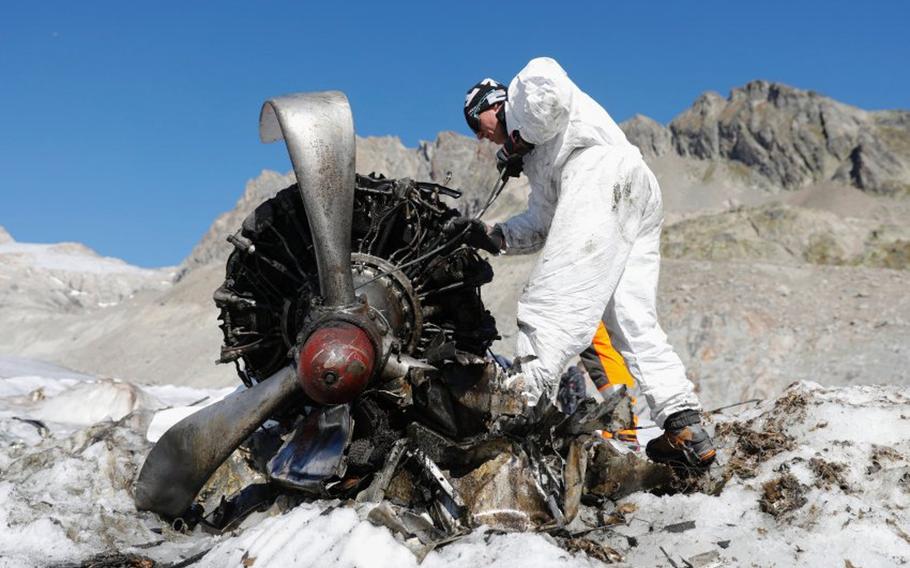
A Swiss soldier works on an engine of a U.S. C-53 Skytrooper that emerged from the ice of the Gauli Glacier in Switzerland in 2018, more than 70 years after the plane crash-landed at the top of the glacier in Nov. 1946. Analysis of ice samples collected from the glacier in 2019 led a scientist to update predictions of where and when the plane's fuselage will emerge from the ice. (Foto VBS)
The fuselage of a U.S. military plane that crash-landed on a Swiss glacier in 1946 will emerge from the ice sooner than expected, near the spot where other parts of the plane have been retrieved, a scientist who studies glaciers has predicted.
Guillaume Jouvet, a glaciologist at the ETH Zurich, one of the world’s leading technical universities, made his prediction after using radioactive traces to accurately date sections of the Gauli Glacier in the Alps, where a U.S. C-53 Skytrooper Dakota crash-landed in 1946, and with a complex model to calculate the trajectory the plane would have taken down the glacier over the years.
The crew and passengers, which included six soldiers, four women and a little girl, were rescued and survived, according to a Nov. 24, 1946 story in Stars and Stripes.
But the president of the Swiss Glacier Commission, ETH’s Paul Louis Mercanton, asked the Americans to leave the plane where it was and allow it to be enveloped by the ice. When it reemerged, he said, it would provide valuable data about the movement of glaciers.
A study published last year predicted that the fuselage would be spat out by the ice no earlier than 2027, more than half a mile up the glacier from the point where several pieces of wreckage — including the propeller, and parts of the engine and wings — have been recovered in recent years.
But the new data, which used radioactive deposits from atmospheric nuclear tests conducted by the U.S. and Soviet Union in the 1950s and early ‘60s to date different sections of the glacier, show that the fuselage is likely to be ejected from the ice sooner and will emerge close to where the other parts were found, Jouvet said.
Earlier sampling in 2018, when some of the plane parts were retrieved, found no traces of plutonium. Scientists feared that radioactivity was being erased from the ice as the glacier melted, making it impossible to use it to date different sections.
But it was still visible in up to 20% of the ice collected last year for Jouvet’s study, published last month in the scientific journal The Cryosphere.
“There were one or two years when the Americans and Soviets really did a lot of tests,” and those years — 1957 and 1962 — were “clearly visible” in the ice in the form of higher radioactive readings, he said.
The radioactive traces stop shortly afterward, corresponding with the signing of the nuclear Non-Proliferation Treaty by the U.S. and USSR in 1963.
A Swiss army unit that wanted to get some alpine training in collected ice from a roughly 1-mile stretch of the glacier and sent it to a lab to be analyzed for radioactive traces left by the nuclear tests.
The plane crashed a decade before the nuclear tests, meaning it would be downstream from the ice from the 1950s.
The data showed that scientists had erred in their earlier calculations of how fast the glacier was moving, and the path the plane has taken down the ice.
“So we recalibrated the model to get the data correct and produced a different trajectory for the plane,” Jouvet said. “With the new model, we have a much more consistent trajectory with the respect to the released pieces,” which were found far down the ice.
Jouvet said he would be “very surprised if the fuselage is far away.”
As for timing, he expects it to emerge “in the coming years,” he said.
“Not next year, but it will happen soon — in the time scale of a glacier.”
zeitvogel.karin@stripes.com Twitter: @StripesZeit